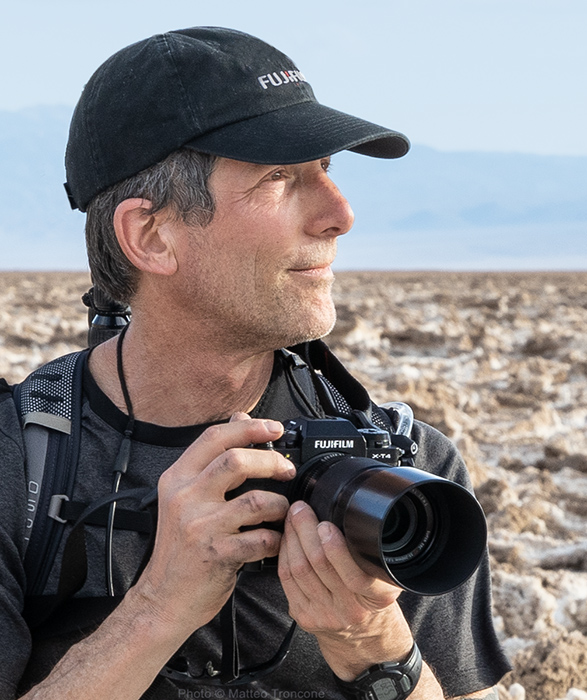There I was, finally alone in the wilds on a photo safari.
Barely off the plane, I met the others in my group and we drove through the busy streets and markets to find some photogenic wildlife. Two hours into our tour, we huddled together, checked our cameras and stared across steamy African wetlands and grasslands.
Suddenly, a territorial bull Antelope surprised me on the grassy hillock, staring me down from just yards away.
My heart pounded, sweat ran beneath my khaki shirt, and then, it happened…

I saw my reflection in the museum diorama’s window glass. Damn!
Thank God I’d brought my Polarizing filter.
I’d flown to San Francisco to visit friends and family, and one of our goals was to see exhibits at the California Academy of Sciences. The exhibits brought me back to fond recollections of my youth, when I spent days touring and examining exhibits at Harvard’s Museum of Comparative Zoology and the Peabody Museum of Archaeology and Ethnography in the hopes of someday traveling to mysterious and picturesque exotic lands.
But on this warm fall day, I plunked down my $30 admission and with a stealthy new Canon Powershot G-15 compact, I set out to learn, daydream and discover something interesting. Photography was not my goal on this trip, but I always have a camera with me, and the G-15 is a light yet full-featured compact with a sensor almost as large as many SLRs. High quality photographs are possible even through glass, beneath mixed lighting, and in a busy environment. These shots would be just for fun, and to see what could be accomplished.
 We covered miles of exhibits, observing paired butterflies, scanning for camouflaged frogs, avoiding snakes and learning more scientific factoids than this aging mind can retain. Soon we found ourselves at the Tuscher African Center, where jaw-dropping dioramas with gorgeously painted scenes surrounding stuffed specimens so lifelike that many kids hid behind their parents. I looked in all directions, judging the lighting, foot traffic and best opportunities.
We covered miles of exhibits, observing paired butterflies, scanning for camouflaged frogs, avoiding snakes and learning more scientific factoids than this aging mind can retain. Soon we found ourselves at the Tuscher African Center, where jaw-dropping dioramas with gorgeously painted scenes surrounding stuffed specimens so lifelike that many kids hid behind their parents. I looked in all directions, judging the lighting, foot traffic and best opportunities.
By carefully using my polarizing filter and shooting in auto, RAW mode and at 400-800 ISO, I knew I’d have a chance for some interesting images. Stability was key as I was shooting at speeds as slow as 1/8 second. I stood or knelt, elbows folded in, comfortable grip and breath slowed for the shot. Still, I was happy to have and enable Canon’s very effective internal stabilization.
Tip: To attach a filter or hood to my camera, I had purchased Canon’s filter adapter from B+H Photo. When researched, the more inexpensive versions lacked a spring-enabled telescopic design that allows unrestricted zooming. When not using a screw-on filter, the matching lens hood helps prevent unwanted stray light from killing the contrast of my images. I ALWAYS use lens hoods. Today’s plastic hoods are also protective, absorbing shock when impact accidents happen. And they will.
Reflections of other exhibits and visitors made shooting clear images a challenge. The polarizing filter, when used carefully, greatly reduced reflections. With a little care of my position and focal length, I was able to minimize almost all reflections. Patience was the key, as I was rarely alone in front of the exhibits. It took time to find the right window of opportunity, and I found that many people gave me few moments of unobstructed access when I lingered, poised for stability, waiting for a clear shot. Photo-hunter’s etiquette.
To apply correct data when later editing images, I often made snapshots of an exhibit’s labels to aid in identifying the subjects in my images. Later, once each ‘keeper’ was named correctly, I deleted the data snapshots to save space. When in doubt or if I forgot to shoot a label, I searched for similar images on Google’s reverse image search.
In Adobe Lightroom 4, I optimized each ‘keeper’ shot, gave a star rating and added keywords to aid in future searches. This workflow rewards me with easy image location and retrieval when I need it most.
Because I shoot in RAW mode, I had lots of rich digital information to work with as I developed each favorite image.
The G-15 did a pretty fine job capturing the colors and textures of this Arrow Poison frog luring in the shadows, behind thick steam terrarium glass.
But a few tweaks of contrast, clarity, vibrance and sharpness improved the image of a tiny frog and it’s environment. Cropping options allowed me to tune the composition, and change it for different uses.
Shooting in the exhibits was indeed fun, and rekindled some goals for travel and further study. It’s a strange experience to capture nature indoors, yet also good training for composition, camera operation and best of all, for patience!
At the very least, you’ll get out of the house, learn something new.
Later, once you’ve edited your image and rated your ‘keepers’, join your friends for a beer and Safari slideshow, and share stories about “the one that got away”.
:-p Dave
Join me for creative adventures on location at one of my workshops, tours and urban safaris. Learn all about it at my Workshops page. Contact me for individual instruction, in person or via free Skype desktop sharing. You’ll learn, practice, review, explore, and won’t get bitten by mosquitos.
Just fill in the blanks to subscribe for more travel stories and techniques in Photography, Lightroom and Photoshop.
I occasionally send out "The Viewfinder" e-newsletter, and provide free presets and workshop discounts.
I never over-post, share your info, and you can opt out at any time.









